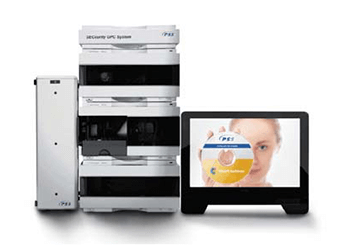Introduction
Graft copolymers are complex products as they exhibit a molar mass and a chemical composition distribution simultaneously. During synthesis side reactions as the formation of homopolymers due to non-grafted species may occur. GPC/SEC dual detection can be used to determine the concentration profiles of the comonomers as function of molecular size, if e.g. one of the comonomers contains chromophores. Polymer-HPLC (Liquid Adsorption Chromatography, LAC) separates based on composition and therefore can differentiate between sample components which cannot be resolved by GPC/SEC due to co-elution. This application note shows the results for a polystyrene-polymethyl methacrylate (PS-PMMA) graft copolymer.

Results
GPC/SEC dual detection using UV254nm and RI-detection has been applied to analyze a poly(methyl methacrylate)-graft-poly(styrene). Figure 1 shows the normalized RI trace (green) and the normalized concentration profiles for polystyrene (red) and PMMA (blue) as a function of GPC/SEC elution volume. The narrow peak at high elution volume is pure polystyrene homopolymer indicating some side reactions during synthesis. Figure 2 shows the results for the LAC run with evaporative light scattering detection. Only here the MMA homopolymer can be identified. This component is co-eluting with the actual graft copolymer in GPC/SEC and is therefore not identified when using a size based separation. A comprehensive characterization, including molar mass determination and composition determination, is possible by 2-dimensional chromatography.

Author & Contact information
Dr. Wolfgang Radke
WRadke@pss-polymer.com
Tel: +49-6131-9623-937
Abstract
A peculiarity of copolymers is the simultaneous presence of a molar mass and a chemical composition distribution. Gradient polymer-HPLC in addition to multidetection GPC/SEC allows identification of all components in a graft copolymer.





